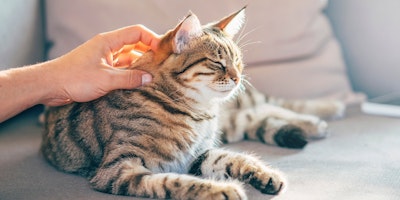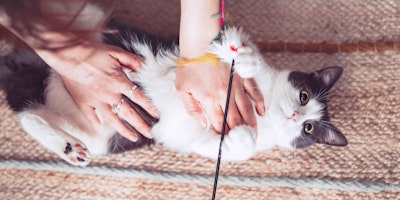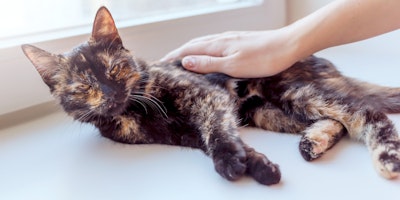
Feline Lower Urinary Tract Disease: Causes & Treatment

Feline lower urinary tract disease (FLUTD) is now known as feline lower urinary tract syndrome (FLUTS). This condition can cause a great amount of discomfort for cats and can be frustrating for pet owners.
Urinary tract infections (UTIs) aren’t as common in cats as they are in dogs. Other urinary system problems like blockages, however, are more common in cats. The good news is If you know what to look for you can get them to the veterinarian quickly and get them on the road to recovery.
Feline urinary tract disease can affect the urinary bladder (such as cystitis, a condition where a cat’s bladder becomes inflamed) and the urethra, which is the channel that carries urine from the bladder out of the cat.
In some cases, cat urinary tract disease arises from crystals or stones that form in the urine. These can irritate the lining of the urinary tract and partially or entirely block the flow of urine.
If your cat is prone to urinary tract problems, your veterinarian may recommend wet cat food or make other suggestions to help maintain urinary tract health.
Understanding FLUTD/FLUTS
Lower urinary tract contributing factors include:
- Stress
- Formation of stones or crystals in the urinary bladder
- Obesity
- Anatomical abnormalities
- Confinement to a small area leading to a lack of exercise
- Genetics
- Bacterial or viral infection
Obesity can cause inflammation throughout the body. Just as obesity can affect the joints and cause arthritis, it can also show up as cystitis or an inflamed bladder. Also, if a cat cannot get in and out of the litterbox easily, they may urinate elsewhere, resulting in a “bad habit.”
Recognizing the Symptoms of Cat Urinary Problems
Accurate observations about changes in your cat’s appearance or behavior can assist your veterinarian in diagnosing feline urinary tract disease. For example, urinating can be painful for a cat with lower urinary tract disease. Urine may be bloody, have a reddish tinge, or a strong ammonia-like odor. A cat with FLUTS may:
- Make frequent trips to the litter box
- Strain to urinate or cry when urinating
- Urinate outside the litter box
- Lick their genital area excessively
Occasionally, mucous plugs or crystals caused by cat urinary tract disease can block the urethra, making it difficult or impossible for your cat to urinate. These cats will:
- Strain to urinate with little success
- Display signs of anxiety, such as pacing or hiding
Consult your veterinarian immediately if your cat shows any of these behaviors. If an obstruction is not relieved, it can lead to vomiting, loss of appetite, dehydration, collapse and even death.
Gender
Both male and female cats can experience cat urinary problems, such as cystitis. Still, since male cats have longer and narrower urethras, their urinary tracts are more likely to become obstructed by crystals and mucous.
Physical Activity
Cats who spend most of their time indoors seem to be more susceptible to cat urinary tract disease. This may be because confinement reduces physical activity, which in turn may reduce the amount of water consumed and the frequency of urination, allowing crystals to form in the urine.
In addition to physical activity, cats need mental enrichment to alleviate stress. Cat enrichment activities can help keep them mentally stimulated and lower their stress levels.
Diet
High levels of ash and magnesium in cat food were once thought to cause crystal formation. More recent work indicates urine pH and urine concentration are more important factors in the development of FLUTD. Increasing water intake is highly recommended to help reduce the risk of FLUTD.
Diagnosing Your Cat’s Urinary Problems
To determine the type and severity of your cat’s urinary disorder, your veterinarian will need to conduct a thorough physical exam. This includes gently feeling your cat’s abdomen to determine if the bladder is distended, a possible sign of a blocked feline urinary tract.
Your veterinarian may also recommend tests such as a urinalysis to evaluate any crystals, blood cells and bacteria in the urine, as well as urine pH and concentration. If a stone formation is suspected, a radiograph (x-ray) will help determine if stones are present. Not all types of urinary stones are visible on x-rays, but struvite stones, one of the most common kinds of bladder stones in cats, generally are.
Helping Your Cat Recover From FLUTD/FLUTS
If your cat has an obstruction, your veterinarian will need to remove it immediately. Most cases of FLUTS are not caused by infection, but if an infection is present, your veterinarian will likely send the urine off for a culture to find out what bacteria is present and which antibiotic is best.
If there are struvite crystals in your cat’s urinary tract that aren’t blocking the flow of urine, a special diet can help dissolve them and reduce future formation. If your cat continues to have lower urinary tract signs after five to seven days of dietary therapy, consult your veterinarian.
Acupuncture, glucosamine/chondroitin sulfate supplements, and other supportive care may be offered depending on your cat’s individual needs and situation.
Regardless of the type of cat urinary disease, increased water intake is recommended to decrease urine concentration and elevate urine volume. Your veterinarian may recommend a special diet that promotes increased water intake or switching to a wet (canned) diet.
Find more about cat health and how to care for them by visiting our Pet Expertise page and get advice from our pet experts.
Related articles


Unlock Cat Health Insights with Petivity
The Smart Litter Box Monitor tracks your cat’s litter box behavior & weight—and alerts you when changes could require a vet visit.

